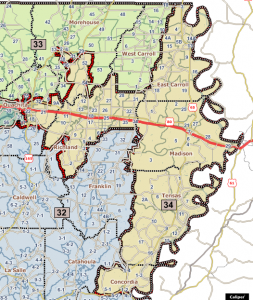Incumbent – Francis Thompson (D – Term Limited in 2019)
District Map
Vote History
|
2008 President |
||
| Current District | New District | |
| John McCain (R) | 13143 (31%) | 15856 (33%) |
| Barack Obama (D) | 28730 (68%) | 32196 (66%) |
| Others | 341 (1%) | 404 (1%) |
|
2008 Senate |
||
| Current District | New District | |
| Mary Landrieu (D) | 28801 (72%) | 10579 (71%) |
| John Kennedy (R) | 32511 (27%) | 12774 (28%) |
| Others | 524 (1%) | 633 (1%) |
|
2010 Senate |
||
| Current District | New District | |
| David Vitter (R) | 7769 (34%) | 9504 (36%) |
| Charlie Melancon (D) | 13716 (59%) | 15425 (58%) |
| Others | 1626 (7%) | 1839 (7%) |
|
2010 Lt Governor |
||
| Current District | New District | |
| Jay Dardenne (R) | 8199 (35%) | 9947 (37%) |
| Caroline Fayard (D) | 14958 (65%) | 16874 (63%) |
Current District
Before the 1991 reapportionment, the only blacks elected to the state senate came, with one exception, from either Baton Rouge or New Orleans. That changed after that year’s reapportionment, and Senate District 34 was one of several districts that the Justice Department mandated to be redrawn as majority black.
District 34 contains all or part of six northeast Louisiana parishes. Not only is there a racial split in the district, but there is also a rural/urban one. The “urban” area is the portion of the district in Ouachita Parish in the black majority precincts in the southern portion of Monroe. This portion of the district casts 53% of the district vote and is 76% black by voter registration. The remainder of the district stretches along the Mississippi River from the black portions of Ferriday in Concordia Parish to the Arkansas line. Connecting these two areas is a section of Richland Parish that is generally north of I-20. This “rural” section of the district is 56% black and is where the remaining 47% of the vote is cast.
Overall, you’re looking at a district that is 67% black and is solidly Democratic: Democrats are pretty much assured of 2/3 of the vote here. However, senate elections have been more competitive than one would think in a district with a 67% black majority because of the presence of the “urban/rural split.” When the district was reconfigured in 1991, Monroe state representative C.D. Jones was only elected 50-45% over a white Democrat; in 1995, Jones only defeated a Republican 59-41%. Even though he was unopposed in 1999 and 2003, it’s worth analyzing the district vote in those first two races. Each time, the vote in the Monroe precincts went along racial lines (he received 67% in 1991 and 75% in 1995), while Jones lost the rural areas both times (with 38% in 1991 and 48% in 1995) – he apparently ran behind the typical Democratic percentages there as a “city” candidate.
When term limits forced Senator Jones to retire in 2007, to the surprise of many, a white candidate (term limited state representative Francis Thompson) was victorious in the first primary. He was able to win that race where other white candidates had failed in the past by rolling up a 64% victory in the rural parishes (he lives in Richland Parish), which when combined with 35% of the vote in Monroe against two black Democrats, enabled him to win 52-40%. (UPDATED 9/9/2011) Senator Thompson is allowed to serve two more terms, and was re-elected without opposition in 2011.
New District
Redistricting was complicated in this part of the state for two reasons: (1) the district was 13% under populated – only districts in Orleans or Saint Bernard Parish were less populated, (2) the Voting Rights Act prevents dilution of minority representation, and with a 67% black voter population, it was hard to add new territory without running afoul of that presumed mandate, depending on your definition of “dilution.” Changes made were mostly made in two areas: (1) a 72% black portion of Morehouse Parish between Bastrop and the Richland Parish line was added, and (2) a large portion of Richland Parish that was 21% black was added back to the district. There were also minor changes made in Ouachita and Concordia Parishes. The end result of these changes was a slight dilution of the black voter registration from 67 to 65%. Additionally, the influence of Ouachita Parish has been significantly reduced from 53 to 44%. (UPDATED 9/9/2011) In these two ways, Senator Thompson’s future re-election position (he was unopposed in 2011) has been significantly strengthened, because a Monroe-based black candidate has to garner a near unanimous black vote in the rural parishes to win.


[…] District Map: Continue reading at http://new.winwithjmc.com/archives/3176 […]
[…] District Map: Continue reading during http://new.winwithjmc.com/archives/3176 […]
Cool sites…
[…]we came across a cool site that you might enjoy. Take a look if you want[…]……
Read was interesting, stay in touch……
[…]please visit the sites we follow, including this one, as it represents our picks from the web[…]……
Related…
[…]just beneath, are numerous totally not related sites to ours, however, they are surely worth going over[…]…